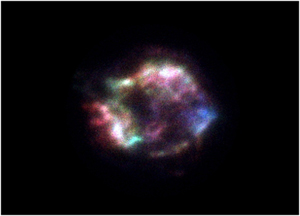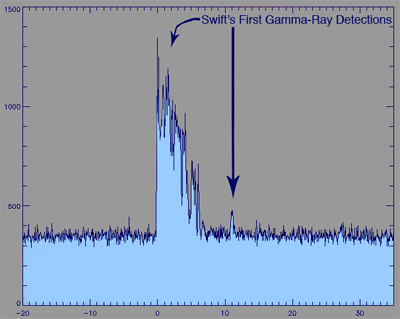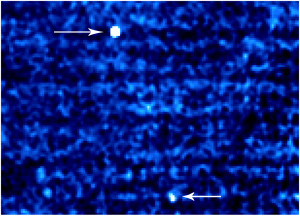Due to the lapse in federal government funding, NASA is not updating this website. We sincerely regret this inconvenience.
NASA Swift Mission Turns On And Sees A Blast Of Bursts
 First-light image from the Swift X-ray Telescope, of the Cassiopeia A supernova remnant, showing the hot gas remaining from the stellar explosion in 1680. This image uses colors to represent different energy X-rays: the lowest X-ray energies are shown in red (mostly emission from material rich in iron), the medium energies are in green (mostly silicon-rich material), and the highest energies are in blue.
First-light image from the Swift X-ray Telescope, of the Cassiopeia A supernova remnant, showing the hot gas remaining from the stellar explosion in 1680. This image uses colors to represent different energy X-rays: the lowest X-ray energies are shown in red (mostly emission from material rich in iron), the medium energies are in green (mostly silicon-rich material), and the highest energies are in blue.+ High Resolution
 The first gamma-ray burst detected by Swift's Burst Alert Telescope was seen on December 11, 2004, beginning at 23:57 (UT). Time is measured on the X-axis; the number of gamma-ray photons is measured on the Y-axis. This chart captures the essence of the gamma-ray burst mystery -- a sudden rush of gamma rays lasting only about 7 seconds, coming seemingly from nowhere and disappearing forever.
The first gamma-ray burst detected by Swift's Burst Alert Telescope was seen on December 11, 2004, beginning at 23:57 (UT). Time is measured on the X-axis; the number of gamma-ray photons is measured on the Y-axis. This chart captures the essence of the gamma-ray burst mystery -- a sudden rush of gamma rays lasting only about 7 seconds, coming seemingly from nowhere and disappearing forever.+ High Resolution
 The Swift BAT's first-light "gamma-ray" image. The bright source at the top of the image is Cygnus X-1, thought to be a stellar-size black hole orbiting a massive star. The bright source at the bottom of the image is Cygnus X-3, a neutron star binary enveloped in a cocoon of swirling dust and gas. What is remarkable about this BAT first-light image is that even the modestly bright Cygnus X-3 can appear in a 6-minute exposure with only three-fourths of the detectors activated. This image captures "soft" or lower-energy gamma rays (also called hard X rays), over a million times more energetic than the visible light that the Hubble Space Telescope detects. Gamma rays cannot be focused like visible light. BAT uses a technique called 'coded mask imaging' to construct an image from the shadow that gamma rays cast through a lead mask above the detectors.
The Swift BAT's first-light "gamma-ray" image. The bright source at the top of the image is Cygnus X-1, thought to be a stellar-size black hole orbiting a massive star. The bright source at the bottom of the image is Cygnus X-3, a neutron star binary enveloped in a cocoon of swirling dust and gas. What is remarkable about this BAT first-light image is that even the modestly bright Cygnus X-3 can appear in a 6-minute exposure with only three-fourths of the detectors activated. This image captures "soft" or lower-energy gamma rays (also called hard X rays), over a million times more energetic than the visible light that the Hubble Space Telescope detects. Gamma rays cannot be focused like visible light. BAT uses a technique called 'coded mask imaging' to construct an image from the shadow that gamma rays cast through a lead mask above the detectors.+ High Resolution


